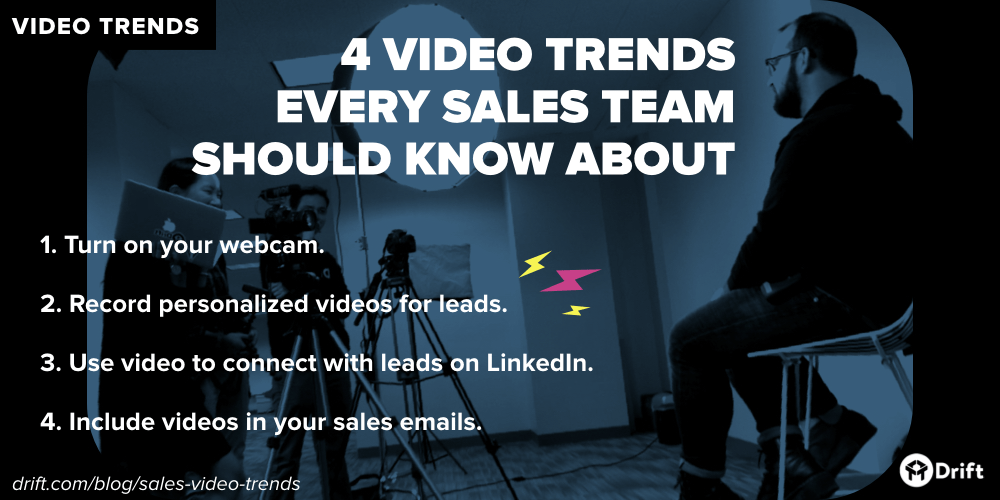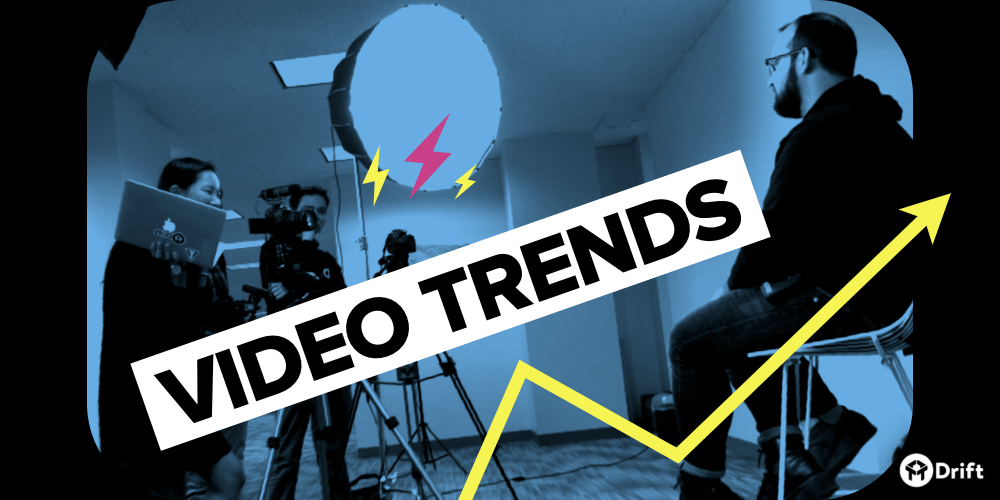
For the past decade, salespeople have typically relegated video to the “nice-to-have” category. It’s something they know has potential, but many still haven’t taken the time to invest in it as a legitimate channel for sales outreach. After all, with phone, email, and now chat available to help bridge the communication divide between buyer and seller, is there really a need for salespeople to add video to that list as well? The short answer:
Heck yes.
Even though chat has revolutionized the way we sell, making it possible for teams to have one-to-one conversations at scale, there’s still no replacing a face-to-face — especially when a rep is trying to get a deal over the finish line. Thanks to the rise of video conferencing solutions, as well as apps that make it super simple to record and send short, personalized videos, sales reps can now provide that face-to-face experience for all of their potential customers.
Ultimately, video is the next best thing to meeting in person. By letting a potential customer put a face to your name (and vice versa), you’re better able to instill a sense of trustworthiness and legitimacy. It also gives you the opportunity to read a person’s body language so you can better diagnose any unspoken pain points or concerns and keep the buying process moving forward.
Today, video accounts for more than 75% of all of the world’s internet traffic. And Cisco’s Visual Networking Index forecasts that by 2022, video will account for 82% of all internet traffic. The takeaway being… video is now the dominant format when it comes to consuming content online. This isn’t some passing fad: Video’s popularity continues to surge.
Fortunately, over the past few years, many businesses have started to take notice. Today, 87% of marketing & sales teams use video on a regular basis, up from just 63% back in 2017.
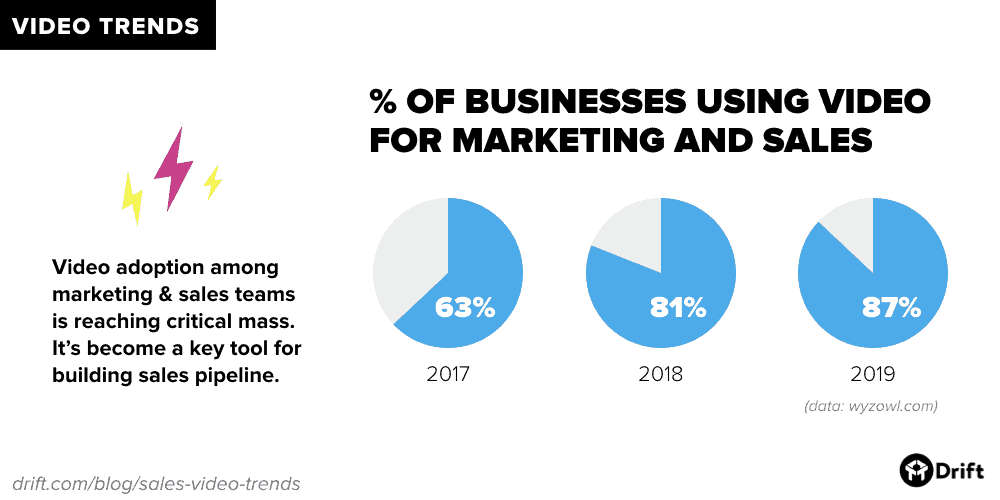
While once thought of as a “nice-to-have,” video is quickly becoming a “must-have” for teams who are looking to grow their sales pipeline and close more deals. At Drift, we’ve identified four key video trends that you can use to update your sales strategy. Keep reading for the full run-down. In a hurry? Here’s the tl;dr version:
- Turn on your webcam. An analysis of more than 100,000 sales meetings found a correlation between deals closed and the amount of time spent chatting face-to-face via video.
- Record personalized videos for leads. Unable to chat live? Sending personalized videos is the next best thing. (It’s a tactic that led one sales team to have a 75% close rate.)
- Use video to connect with leads on LinkedIn. With only 51% of marketing & sales teams taking advantage of LinkedIn’s video environment, this niche platform is a largely untapped source of B2B sales opportunities.
- Include videos in your sales emails. A recent survey of high-performing cold emails found that a mere 6% included video. Once again, we see untapped potential — especially when you consider that emails containing video have been shown to increase click-through rates by 4x.
1) Turn on your webcam.
Our friends at Gong.io recently analyzed the audio and video of more than 100,000 sales meetings to understand the effect using a webcam has on closing deals. When comparing meetings that resulted in successful, closed/won deals to meetings that resulted in unsuccessful, closed/lost deals, Gong.io made a remarkable discovery: For the closed/won deals, webcams were used 41% more frequently throughout the sales cycle.
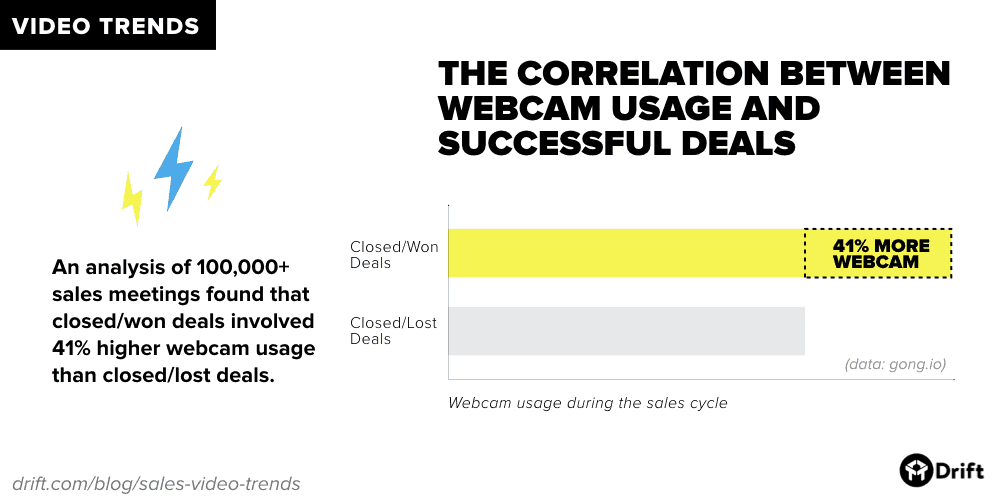
The implication, of course, is that keeping your webcam turned on for longer and spending more time communicating via video conferencing will increase your odds of closing a deal. But it turns out that the research offers even more granular advice than that. According to Gong.io’s Chris Orlob, the top sales reps do more than just keep their webcams turned on — they spend more time showing their actual faces, as opposed to showing a presentation or product demo.
To quote Chris:
Not only do they have their webcams on to begin with, but they also spend more time during their meetings having face time via the webcam.
Instead of spending most of the meeting sharing their screen to present a deck or demo a product, top sellers spend much more time virtually “face to face” on the webcam.
2) Record personalized videos for leads.
Understandably, sales reps aren’t always available to chat with all of their leads via live video at a moment’s notice. But that doesn’t mean, as a rep, that you can’t show your face and make your presence known by sending short, personalized videos to the leads you’re most interested in talking to. Even if your leads live in a different hemisphere, you can make a connection that feels human and personal and address issues and challenges that are specific to them.

The SalesLoft sales team recently ran an experiment where they created personalized videos for 20 sales reps who needed help getting deals over the finish line. By the end of the quarter, 15 of those reps (75%) had successfully closed their deals. To quote SalesLoft:
You don’t have to be in the sales game very long to know that a 75% close rate is no joke. But what is it about personalized videos that makes them so effective?
Personalized videos make effective sales engagement tools because people do business with people, not entities. Being able to see you, your expression, your body language, immediately makes your message harder to ignore.
With the traditional approach to sales, where you force people to fill out forms and make them wait, the buying experience can feel overly automated and anonymous. By recording and sharing personalized videos, you’re signaling to potential customers that you’re a living, breathing person who can help guide them through the buying process. And you’re also signaling to them that your sales organization takes a modern, conversational approach to selling — an approach that places a huge emphasis on authenticity and one-to-one engagement.
3) Use video to connect with leads on LinkedIn.
For years, YouTube and Facebook have been the most popular channels for sharing sales & marketing videos. And when you look at the numbers today, the story remains the same: YouTube and Facebook reign supreme, with 87% of businesses now sharing videos on the former and 84% sharing videos on the latter. Instagram (51%), LinkedIn (51%), and Twitter (45%), meanwhile, make up a distinct, second tier. But of those “second-tier” video platforms, LinkedIn, in particular, stands out as presenting a huge opportunity for sales teams — especially those in B2B sales.
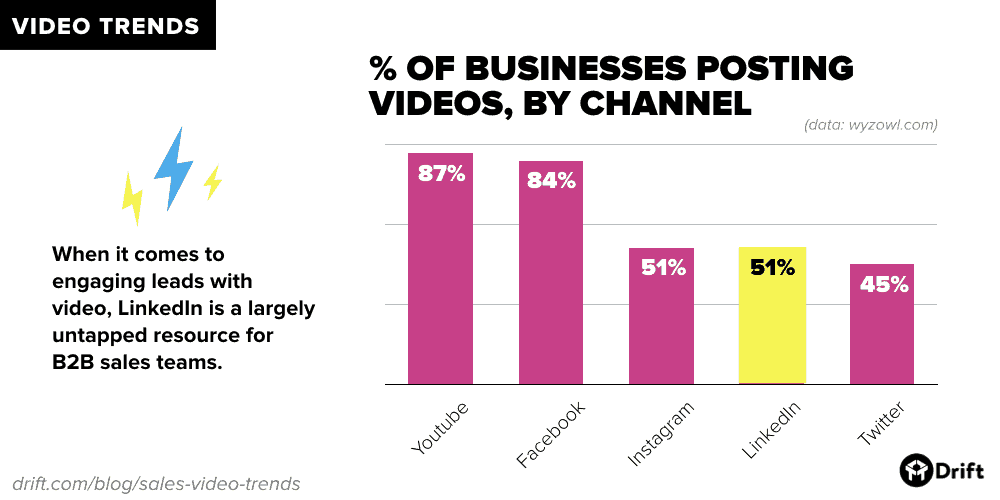
Because of the niche, business-focused nature of LinkedIn, it’s the perfect environment for sharing videos that speak to potential buyers. In fact, an internal study conducted at LinkedIn showed that finding a “quality environment” in which to run video campaigns has been a top challenge for 46% of B2B advertisers. And through unveiling new features in recent years, like video for Company Pages and video for Sponsored Content, LinkedIn has made it clear that it is fully embracing the video megatrend.
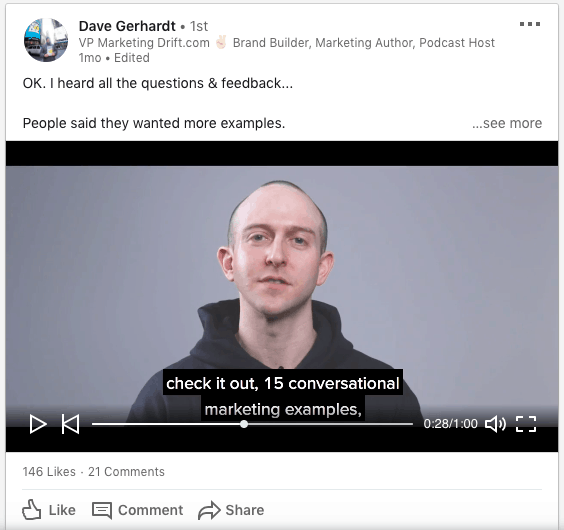
At Drift, we’ve witnessed the power of posting videos to LinkedIn first-hand. Just ask our VP of Marketing Dave Gerhardt, who, for months, has been able to consistently garner 100,000+ views on the LinkedIn videos he posts. What’s more, all of those views tend to come within the first week of him posting. Dave (who admittedly isn’t a video expert) shot a lot of these videos on his iPhone and didn’t spend a single dollar on promoting them. His biggest “hack” for driving results?
Consistency.
To quote Dave:
Once you find a channel, the key is to go deep — learn it in and out and use it every day to master it… consistency is the MOST important ingredient to building an audience.
4) Include videos in your sales emails.
A recent study that looked at 290 of the most successful cold sales emails found that just 13% included multimedia of any kind, and only 6% included video.
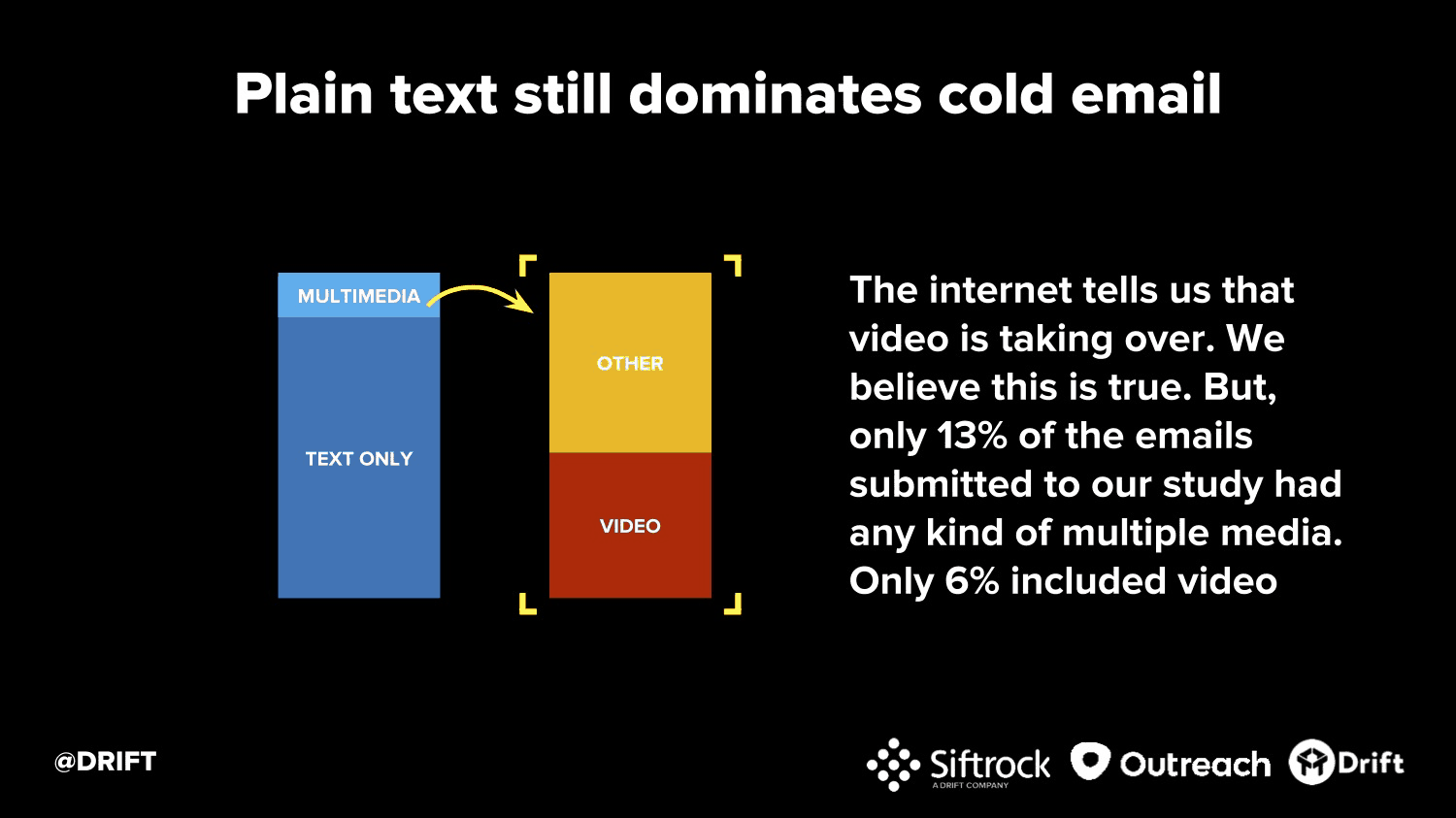
Clearly, we’re still in the early days of including video in sales emails. But when you consider that emails containing video have been shown to receive 4x higher click-through rates, there’s a lot of opportunity for you to gain a competitive advantage by using it.
And while recording personalized videos (which we talked about earlier) and including them in emails makes sense for leads who are at the bottom of your sales funnel, what about all those leads at the top of the funnel?
One trend that has been emerging is to include a video in your email signature. It’s a place where you, as a rep, can introduce yourself and/or give a brief walkthrough of your company’s product. What’s more, you can use these videos to ask questions and engage potential customers (as well as existing customers) on a level you can’t achieve with text alone. By giving people the chance to see you and hear you and experience your personality up front, you can help make the buying experience feel more human — even in a cold email.
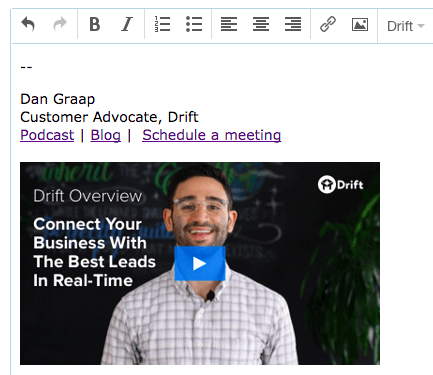
Final Thoughts
Video (along with messaging) is one of two megatrends that’s forcing sales teams to rethink the way businesses buy from businesses. In order for your sales team to succeed in a world where trust and authenticity are more important than ever, reps need to take advantage of video so they can show their faces (and body language) and make more human connections.
Here’s a recap of the four video trends your team can start capitalizing on today:
